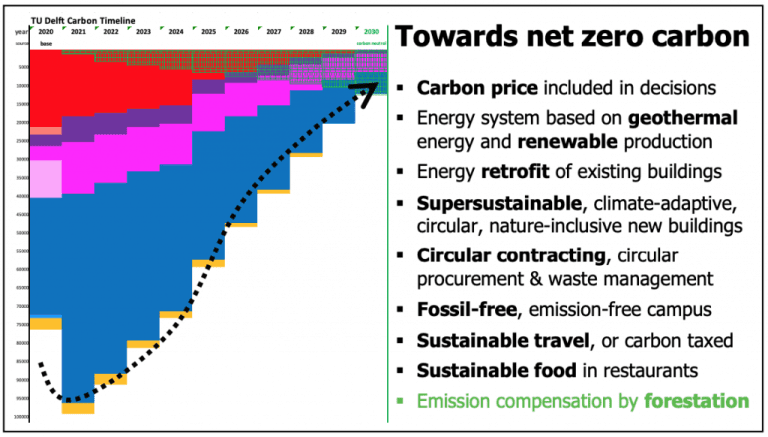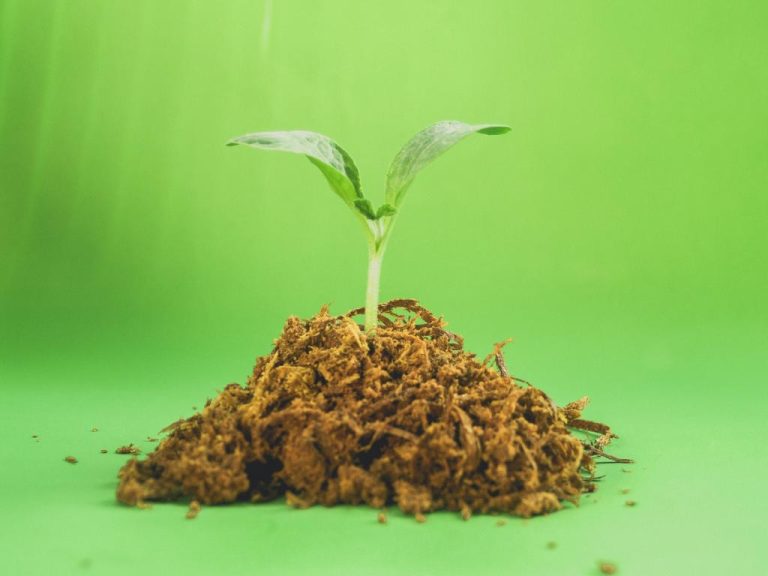In his role as Sustainability Coordinator. Andy van den Dobbelsteen has set an ambitious target – a green and climate neutral campus in eight years’ time. What is the plan?
A vegetarian offer in the canteens, as here at Bouwkunde, reduces the CO2 footprint of the campus and its residents. (Photo: Andy van den Dobbelsteen)
No progress without data. The campaign for a climate neutral campus thus started with a new sustainability website. It serves as a dashboard in reducing the CO2 footprint related to heating buildings, food provision, travel and so on. The sustainability website is a continuation of the CO2 roadmap that TU Delft’s Campus & Real Estate property company commissioned Prof. Andy van den Dobbelsteen and Tess Blom to produce.
As a baseline for the curve towards sustainability in 2030, the researchers are taking figures from 2020 whose total CO2 footprint was 70,500 tonnes CO2 equivalent (which includes all the greenhouse gas emissions taken together). What was it like before that? Are there any signs of a reduction? It does not appear so as for 2018 and 2019 we find figures of about 50,000 tonnes of CO2 equivalent. So why is it one-and-a-half times more in 2020?
“The 2018 and 2019 figures do not include procurement (the purchase of goods, furniture, equipment, services etc.)’ writes Van den Dobbelsteen in a response. ‘This makes the total figures of these years twice as high. Procurement is even the biggest factor. Before 2020 we made up for the lower corona figures with procurement. It also includes what people consumed in energy and food at home during corona. So that 70,000 tonnes is much more than the previous years.”
This is the reason that 2020 is taken for the CO2 baseline.
Sources of CO2 footprint
The emissions in that corona year emerged from: energy from the built environment (red); energy at home (orange); business flights (purple); food (magenta); food at home (light magenta); purchase of goods, use of raw materials and water, and waste processing (blue); water consumption at home (light blue), and purchase of services (yellow). (Source: Climate Alliance reading by Andy van den Dobbelsteen on 3 February 2022.)
Reducing step by step
On reaching climate neutrality in eight years’ time, the website says: ‘Achieving CO2 neutrality in 2030 needs major involvement and the participation of all faculties and services, from procurement to building management to communications. As an example, think about the restaurant at the Faculty of Architecture and the Built Environment becoming vegetarian. TU Delft will also have to work closely with partners outside the organisation.’
Another figure quoted by Van den Dobbelsteen in his lecture shows how that could be done.

The emissions for heating (red) are steadily decreasing because of energy saving measures in existing buildings and ‘climate adaptive’ new builds. There is likely to be a sudden drop in emissions in 2025 when geothermal heating starts being used. Geoengineering Project Leader Phil Vardon even hopes that the geothermal heating can be adopted earlier. Business flights (purple) will be cut back to corona levels. Intercontinental contact will mostly be done online; remaining flights will be charged a CO2 levy. Commuting has become sustainable. Food related emissions are lower (more plant-based than animal-based foods) but not zero. This also applies to the greenhouse gas emissions associated with procured goods and services (‘procurement’, blue). What then remains is a small CO2 footprint of about 10,000 tonnes (about 14% of the 2022 footprint).
Additional green planting

40 thousand trees per year provides a climate compensation of one thousand tonnes of CO2. (Photo: Pxhere)
On top of this, an increasing compensation of 1,000 tonnes of CO2 a year through planting green is proposed. ‘How we arrange the planting of trees is still under discussion. We will work it out for the Executive Board so that a decision can be taken before the summer’, writes Van den Dobbelsteen. ‘If it were up to me, it could be a combination of CO2 binding through things like planting more green and trees, and peat formation, on top of planting forests elsewhere. The last one can be done through contracts with an organisation that can do it for us, for example Trees for All.’
If all goes according to plan, there will be 10,000 tonnes of CO2 absorption against the same level of unavoidable emissions. Result: climate neutrality.
- More information: tudelft.nl/sustainability
Do you have a question or comment about this article?
j.w.wassink@tudelft.nl


Comments are closed.